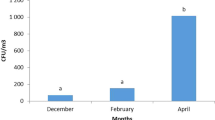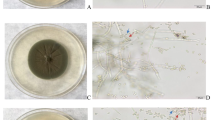Abstract
Fungal spores are normal components of external environments. They have been reported to be associated with human, animal and plant diseases causing primary and opportunistic infections. Cladosporium is commonly the most frequently isolated genus from air samples, and its species are considered mainly saprophytic, but there is a wide variety of taxa that can cause adverse effects on human and animal health and also on plants. In this work, we aimed to record Cladosporium spores frequency of isolation in northern Argentinean Patagonia and to perform a molecular characterization based on actin gene complemented with EF1α and ITS genes. The ability of the pathogens to cause disease in pip fruits of Packham’s Triumph and Abate Fetel pears and red delicious apples was determined. Results confirmed Cladosporium spores as the main genera isolated from air samples, and the molecular characterization revealed the existence of 11 species in this region grouped in C. cladosporioides and C. herbarum complexes. Pathogenicity tests revealed that Cladosporium sp. cause disease on fruit. Abate Fetel was the most susceptible to infection. These results compose the first study in Argentina in respect of identification at species level of airborne Cladosporium spores, and furthermore, it is the first report in northern Patagonia and the high valley of Río Negro productive region. This knowledge can help farmers to take preventive measures in order to avoid biological damage.




Similar content being viewed by others
References
Abdel Hameed, A. A., Khoder, M. I., Yuosra, S., Osman, A. M., & Ghanem, S. (2009). Diurnal distribution of airborne bacteria and fungi in the atmosphere of Helwan area, Egypt. Science of the Total Environment, 407, 6217–6222.
Aira, M. J., Rodríguez-Rajo, F. J., Fernández-González, M., Seijo, C., Elvira-Rendueles, B., Gutiérrez-Bustillo Abreu, I., et al. (2012). Cladosporium airborne spore incidence in the environmental quality of the Iberian Peninsula. Grana, 51(4), 293–304.
Al-Doory, Y., & Domson, J. F. (1984). Mould allergy. Philadelphia, PA: Lea and Febiger.
Alhussaini, M. S., Moslem, M. A., Alghonaim, M. I., Al-Ghanayem, A. A., & Hefny, H. M. (2015). Biological studies on airborne Cladosporium species isolated from Riyadh City. Life Science Journal, 12(6), 83–91.
Andersen, B., Kroger, E., & Roberts, R. (2002). Chemical and morphological segregation of Alternaria arborescens, A. infectoria and A. tenuissima species-groups. Mycological Research, 106(2), 170–182.
Aríngoli, E. E., Basílico, M. Z., Altahus, R. L., & Basílico, J. C. (2008). Multivariate analysis of fungal associations in the indoor air of Argentinean houses. International Biodeterioration and Biodegradation, 62, 281–286.
Artac, H., Kizilpinar, I., Pekcan, S., Dogan, C., & Reisli, I. (2009). Alternaria and Cladosporium spores in the atmosphere of Konya, Turkey. Allergy: European Journal of Allergy and Clinical Immunology, 64, 248–249.
Benbow, J. M., & Sugar, D. (1999). Fruit surface colonization and biological control of postharvest diseases of pear by preharvest yeast applications. Plant Disease, 83, 839–844.
Bensch, K., Braun, U., Groenewald, J. Z., & Crous, P. W. (2012). The genus Cladosporium. Studies in Mycology, 72, 1–401.
Bensch, K., Groenewald, J. Z., Dijksterhuis, J., Starink-Willemse, M., Andersen, B., Shin, H.-D., et al. (2010). Species and ecological diversity within the Cladosporium cladosporioides complex (Davidiellaceae, Capnodiales). Studies in Mycology, 67, 1–94.
Braun, U. (2003). Miscellaneous notes on some cercosporoid hyphomycetes. Bibliotheca Lichenologica, 86, 79–98.
Bueno, D. J., Silva, J. O., & Oliver, G. (2003). Hongos ambientales en una biblioteca: un año de estudio. Anales de Documentación, 6, 27–34.
Carbone, I., & Kohn, L. M. (1999). A method for designing primer sets for speciation studies in filamentous ascomycetes. Mycologia, 91, 553–556.
Cvetnic, Z., & Pepelnjak, S. (1997). Distribution and mycotoxin-producing ability of some fungal isolates from the air. Atmospheric Environment, 31, 491–495.
Domsch, K. H., Gams, W., & Anderson, T. H. (1980). Compendium of soil fungi (Vols. 1 & 2). London: Academic Press.
Dugan, F. M., Braun, U., Groenewald, J. Z., & Crous, P. W. (2008). Morphological plasticity in Cladosporium sphaerospermum. Persoonia, 21, 9–16.
Dugan, F. M., Schubert, K., & Braun, U. (2004). Check-list of Cladosporium names. Schlechtendalia, 11, 1–103.
Edgar, R. C. (2004). MUSCLE: Multiple sequence alignment with high accuracy and high throughput. Nucleic Acids Research, 32, 1792–1797.
Erkara, I. P., Asan, A., Yilmaz, V., Pehlivan, S., & Okten, S. S. (2008). Airborne Alternaria and Cladosporium species and relationship with meteorological conditions in Eskisehir City, Turkey. Environmental Monitoring and Assessment, 144(1), 31–41.
Fang, Z., Ouyang, Z., Hu, L., Wang, X., Zheng, H., & Lin, X. (2005). Culturable airborne fungi in outdoor environments in Beijing, China. Science of the Total Environment, 350, 47–58.
Greco, M., Kemppainen, M., Pose, G., & Pardo, A. (2015). Taxonomic characterization and secondary metabolite profiling of Aspergillus section Aspergillus contaminating feeds and feedstuffs. Toxins, 7(9), 3512–3537.
Grinn-Gofroń, A., Strzelczak, A., & Wolski, T. (2011). The relationships between air pollutants, meteorological parameters and concentration of airborne fungal spores. Environmental Pollution, 159, 602–608.
Kulko, A. B., & Marfenina, O. E. (2001). Distribution of microscopic fungi along Moscow roads. Mikrobiologia, 70, 709–771.
Kumar, S., Stecher, G., & Tamura, K. (2016). MEGA7: Molecular evolutionary genetics analysis version 7.0 for bigger datasets. Molecular Biology and Evolution, 33, 1870–1874.
Lee, T., Grinshpun, S. A., Martuzevicius, D., Adhikari, A., Crawford, C. M., & Reponen, T. (2006). Culturability and concentration of indoor and outdoor airborne fungi in six single-family homes. Atmospheric Environment, 40, 2902–2910.
Lutz, C. M., Sosa, C. M., & Colodner, A. (2016). Effect of pre and postharvest application of fungicides on postharvest decay of Bosc pear caused by Alternaria-Cladosporium complex in North Patagonia. Argentina: Scientia Horticulturae. https://doi.org/10.1016/j.scienta.2017.05.007.
Mitakakis, T. Z., & Guest, D. I. (2001). A fungal spore calendar for the atmosphere of Melbourne, Australia, for the year 1993. Aerobiologia, 17, 171–176.
Muhsin, T. M., & Adlan, M. M. (2012). Seasonal distribution pattern of outdoor airborne fungi in Basrah city, southern Iraq. Journal of Basrah Researches, 38(1A), 90–98.
Mullins, J. (2001). Microorganisms in outdoor air. In R. A. Samson & J. D. Miller (Eds.), Microorganisms in home and indoor work environments: Diversity, health impacts, investigation and control (flannigan B (pp. 3–16). London: Taylor and Francis.
Park, H. G., Managbanag, J. R., Stamenova, E. K., & Jong, S. C. (2004). Comparative analysis of common indoor Cladosporium species based on molecular data and conidial characters. Mycotaxon, 89(2), 441–451.
Park, Y. S., Kim, K. C., Lee, J. H., Cho, S. M., Choi, Y. S., & Kim, Y. C. (2008). Cladosporium sp. is the major causal agent in the microbial complex associated with the skin sooty dapple disease of the asian pear in Korea. The Plant Pathology Journal, 24(2), 118–124.
Pitt, J., & Hocking, A. (2009). Fungi and food spoilage (3rd ed.). New York, NY: Springer.
Robbins, C. A., Swenson, L. J., Nealley, M. L., Gots, R. E., & Kelman, B. J. (2000). Health effects of mycotoxins in indoor air: A critical review. Applied Occupational and Environmental Hygiene, 15, 773–784.
Rodríguez, A., & Muñoz, A. (2006). Síntesis Agrometeorológica para el período 1990-2004. EEA Alto Valle. Ed. INTA. Boletín Divulgación Técnica, (53), 38.
Samson, R., Hoekstra, E., Frisvad, J., & Filtenborg, O. (2000). Introduction to food- and airborne fungi (6ª ed.). Utrecht: Centraalbureau Voor Schímmelcultures.
Sandoval-Denis, M., Sutton, D. A., Martin-Vicente, A., Cano-Lira, J. F., Wiederhold, N., Guarro, J., et al. (2015). Cladosporium species recovered from clinical samples in the United States. Journal of Clinical Microbiology, 53, 2990–3000. https://doi.org/10.1128/JCM.01482-1.
Schubert, K., Groenewald, J. Z., Braun, U., Dijksterhuis, J., Starink, M. S., Hill, C. F., et al. (2007). Biodiversity in the Cladosporium herbarum complex (Davidiellaceae, Capnodiales), with standardisation of methods for Cladosporium taxonomy and diagnostics. Studies in Mycology, 58, 105–156.
Shelton, B. G., Kirkland, K. H., Flanders, W. D., & Morris, G. K. (2002). Profiles of airborne fungi in buildings and outdoor environments in the United States. Applied and Environmental Microbiology, 68, 1743–1753.
Sindt, C., Besancenot, J. P., & Thibaudon, M. (2016). Airborne Cladosporium fungal spores and climate change in France. Aerobiologia, 32(1), 53–68.
Sugar, D., & Powers, K. (1986). Interactions among fungi causing postharvest decay of pear. Plant Disease, 70, 1132–1134.
Tournas, V. H. (2005). Spoilage of vegetable crops by bacteria and fungi and related health hazards. Critical Reviews in Microbiology, 31, 33–44.
Verhoeff, A. P., Van Wijnen, J. H., Boleij, J. S. M., Brunekreef, B., Van Reenen-Hoekstra, E. S., & Samson, R. A. (1990). Enumeration and identification of airborne viable mould propagules in houses. Allergy, 45, 275–284.
White, T. J., Bruns, T., Lee, S., & Taylor, J. (1990). Amplification and direct sequencing of fungal ribosomal RNA genes for phylogenetics. In D. H. Gelfand, J. J. Sninsky, & T. J. White (Eds.), PCR Protocols: A guide to methods and applications (Innis MA (pp. 315–322). San Diego, CA: Academic Press.
Zalar, P., de Hoog, G. S., Schroers, H.-J., Crous, P. W., Groenewald, J. Z., & Gunde-Cimerman, N. (2007). Phylogeny and ecology of the ubiquitous saprobe Cladosporium sphaerospermum, with descriptions of seven new species from hypersaline environments. Studies in Mycology, 58, 157–183.
Acknowledgements
The authors acknowledge Javier Alonso (Universidad Nacional de Río Negro), Consejo Nacional de Investigaciones Científicas y Técnicas (CONICET), Universidad Nacional de Río Negro (UNRN) (Grant No. PI 40-A-382) and Universidad Nacional de Quilmes (UNQ) for financial support.
Author information
Authors and Affiliations
Corresponding author
Ethics declarations
Conflict of interest
The authors declare that they have no conflict of interest.
Rights and permissions
About this article
Cite this article
Temperini, C.V., Pardo, A.G. & Pose, G.N. Diversity of airborne Cladosporium species isolated from agricultural environments of northern Argentinean Patagonia: molecular characterization and plant pathogenicity. Aerobiologia 34, 227–239 (2018). https://doi.org/10.1007/s10453-018-9509-7
Received:
Accepted:
Published:
Issue Date:
DOI: https://doi.org/10.1007/s10453-018-9509-7




